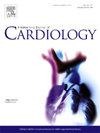Systemic immune-inflammation index as a predictor of statin residual cardiovascular risk compared with C-reactive protein
IF 3.2
2区 医学
Q2 CARDIAC & CARDIOVASCULAR SYSTEMS
引用次数: 0
Abstract
Background
Despite statins reducing cardiovascular (CV) disease risk, residual inflammatory risk persists in treated patients. The systemic immune-inflammation index (SII), integrating platelet, neutrophil, and lymphocyte counts, has emerged as a novel biomarker of systemic inflammation and immune dysregulation. This study evaluated the systemic immune-inflammation index (SII) as a predictor of residual CV mortality compared to C-reactive protein (CRP) in statin users.
Method
This study included 8211 adults with statin use from the National Health and Nutritional Examination Surveys (NHANES) 1999–2018 and were followed for survival through December 31, 2019. Cox proportional hazard models were used to investigate the associations between natural log-transformed SII (lnSII) and cardiovascular mortality. Predictive accuracy was compared via receiver operating characteristic (ROC) curves.
Result
During the follow-up period of 6.92 (3.75, 11) years, a total of 2261 all-cause deaths and 796 cardiovascular deaths were recorded. After adjusting for covariates, higher baseline SII was significantly associated with an elevated risk of CV mortality (hazard ratio [HR] for per unit increase in natural log-transformed SII (lnSII), 1.241; 95 % confidence interval [CI], 1.009–1.527). The ROC curve analysis demonstrated SII's superior predictive accuracy (AUC, 0.760; 95 %CI, 0.744–0.776) over CRP (AUC, 0.749; 95 % CI, 0.733–0.765).
Conclusion
Among patients receiving contemporary statins, SII was shown to be an independent predictor of future CV death. SII outperformed CRP as an inflammatory biomarker for residual CV risk in statin-treated patients.

与c反应蛋白相比,全身免疫炎症指数作为他汀类药物残留心血管风险的预测因子。
背景:尽管他汀类药物降低了心血管(CV)疾病的风险,但在接受治疗的患者中,残余炎症风险仍然存在。综合血小板、中性粒细胞和淋巴细胞计数的全身性免疫炎症指数(SII)已成为全身性炎症和免疫失调的一种新的生物标志物。本研究评估了与c反应蛋白(CRP)相比,他汀类药物使用者的全身免疫炎症指数(SII)作为剩余CV死亡率的预测因子。方法:本研究纳入了1999-2018年国家健康与营养调查(NHANES)中使用他汀类药物的8211名成年人,并随访至2019年12月31日。Cox比例风险模型用于研究自然对数转换SII (lnSII)与心血管死亡率之间的关系。通过受试者工作特征(ROC)曲线比较预测准确度。结果:在6.92(3.75,11)年的随访期间,共记录全因死亡2261例,心血管死亡796例。在调整协变量后,较高的基线SII与CV死亡风险升高显著相关(自然对数转化SII (lnSII)每单位增加的风险比[HR]为1.241;95 %置信区间[CI], 1.009-1.527)。ROC曲线分析表明,SII具有较好的预测精度(AUC, 0.760;95 %CI, 0.744-0.776)高于CRP (AUC, 0.749;95 % ci, 0.733-0.765)。结论:在接受当代他汀类药物治疗的患者中,SII被证明是未来CV死亡的独立预测因子。SII作为他汀类药物治疗患者剩余CV风险的炎症生物标志物优于CRP。
本文章由计算机程序翻译,如有差异,请以英文原文为准。
求助全文
约1分钟内获得全文
求助全文
来源期刊

International journal of cardiology
医学-心血管系统
CiteScore
6.80
自引率
5.70%
发文量
758
审稿时长
44 days
期刊介绍:
The International Journal of Cardiology is devoted to cardiology in the broadest sense. Both basic research and clinical papers can be submitted. The journal serves the interest of both practicing clinicians and researchers.
In addition to original papers, we are launching a range of new manuscript types, including Consensus and Position Papers, Systematic Reviews, Meta-analyses, and Short communications. Case reports are no longer acceptable. Controversial techniques, issues on health policy and social medicine are discussed and serve as useful tools for encouraging debate.
 求助内容:
求助内容: 应助结果提醒方式:
应助结果提醒方式:


